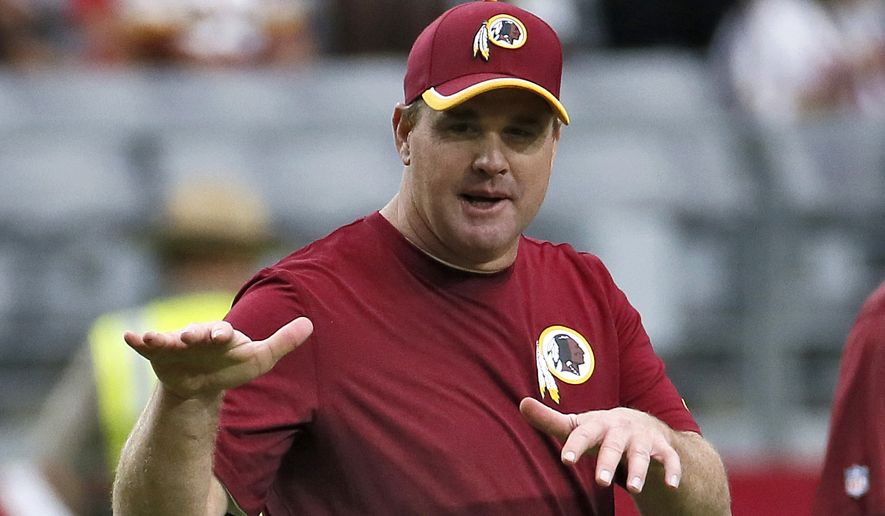Mike Zimmer arrived in Minneapolis in mid-January and immediately made wholesale changes.
The Vikings’ new coach didn’t just hire several new assistants and change the weekly practice schedule. Zimmer rearranged the Vikings’ weight room, tweaked the lifting schedule, overhauled the nutritional program and added a team meeting room that he believed would foster more of an educational environment.
“It wasn’t based on anything that they had done in the past,” Zimmer said. “It was just things that I wanted to do.”
Zimmer was careful to absolve former coach Leslie Frazier of blame for the team’s recent struggles, but his statement was clear. Many things needed to change in Minnesota, as the Vikings won five games in 2013 and Frazier went 18-29-1 in three full seasons as their coach before being fired on Dec. 30.
On Sunday, the Vikings will face the Washington Redskins, a team that has been as bereft of success in recent years. Their coach, Jay Gruden — formerly the offensive coordinator in Cincinnati, where Zimmer was the defensive coordinator — did not make many changes upon accepting a new job in January. Instead, he chose to retain a good number of assistant coaches, inherited a recently renovated practice facility and kept the practice schedule mostly intact.
Regardless of the coaches’ strategies, the two teams find themselves in a similar place. Following overtime victories last weekend, they enter Sunday with 3-5 records, have struggled to score points on offense, are woeful in prolonging drives and have defenses that are starting to find an identity.
In recent seasons, teams hiring new coaches have been infused with new ideas and a fresh start, with several of them achieving immediate success. Of the eight teams who hired new coaches prior to the 2013 season, five of them won at least eight games, with three making the playoffs.
This year, only one has seen significant improvement under its new coach — the Detroit Lions, at 6-2 under Jim Caldwell. Even then, the Lions finished 7-9 last season and returned nearly all of their marquee players, making their turnaround less drastic than the ones faced by coaches such as Gruden and Zimmer.
“I think most importantly, you understand that it’s the NFL and it’s a result-based business,” said defensive end Kedric Golston, who, in his ninth season, has only played for the Redskins. “If players don’t get it done, they get replaced. If coaches don’t get it done — or the results aren’t what everybody thinks they should be — they get replaced.”
Golston was fortunate this past offseason to have the opportunity to continue to work with defensive coordinator Jim Haslett and defensive line coach Jacob Burney, each of whom were retained by Gruden.
That wasn’t the case during the last coaching change, when the Redskins dumped coach Jim Zorn and defensive coordinator Greg Blache. Upon hiring Mike Shanahan as coach and Haslett as defensive coordinator, Washington revamped its defense, going from a 4-3 scheme to the 3-4 — something Golston had never played before.
“I understand that they wanted me to do, but I didn’t understand, like I said, the big picture or the big scope or what the coaches were looking for and how they envision the defense being played,” Golston said. “Even if you change position coaches, just getting on the same page, as far as terminology and what the coach expects from you, [can be tough]. You might know the defense, know the system, but [not] the intricate details of what that coach is looking for, the overall plan, or how he sees the defense, the defensive line, and how he wants that to develop.”
Chad Greenway, like Golston, was drafted in 2006, and he and has spent his entire career with the Vikings. He rifled through a list of things that have happened during his tenure in Minnesota — the signing of quarterback Brett Favre in 2009, the return of wide receiver Randy Moss in 2010, the collapse of the Metrodome roof later that season, two coaching changes — and said that as a player, he’s learned over the years to only focus on his own job.
“When you sign a contract, on the dotted line, to stay with an organization and accept payment for your services, you need to make sure you’re doing your part to make your team and your organization better,” said Greenway, the Vikings’ starting weakside linebacker. “It’s not just going to be anointed to you that you’re going to be good and you’re going to win. It’s a battle every year in this league, and I think it’s impossible — unless you fall into that perfect category of getting drafted with Peyton Manning — that you’re going to go to the playoffs eight, nine, 10 years in a row.”
While Greenway has never tested free agency, having signed a five-year extension that runs through next year after his rookie contract expired, Golston has had the opportunity to do so twice, choosing to stay with the Redskins in 2010 and in 2013.
“I wanted to be a part of the solution,” Golston said. “I do believe that we have brighter days ahead.”
So does Zimmer, who reportedly interviewed for a coaching opening on five occasions yet came up short until he was hired by Minnesota.
Many of his changes to the Vikings’ operations were drawn from the setup run by Hall of Fame coach Bill Parcells, who made sure Zimmer, Parcells’ defensive coordinator in Dallas from 2003 through 2006, was prepared for the day he’d run his own team.
“He came every day into my office and said, ’When you’re a head coach, remember this,’” Zimmer said. “I think his personality or mine — we’ve said this before, and I’m not sure it’s a good thing for either of us — but our personalities seem to be fairly similar.”
• Zac Boyer can be reached at zboyer@washingtontimes.com.




Please read our comment policy before commenting.